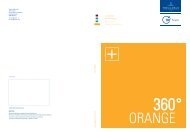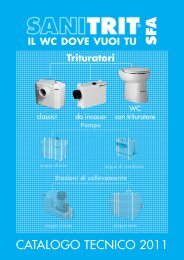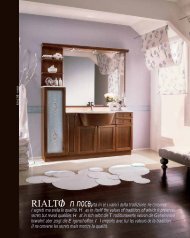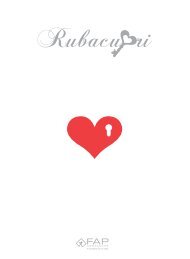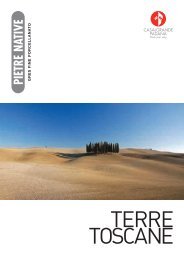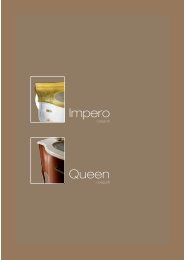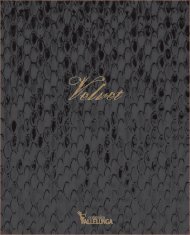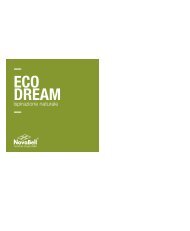Mono' Noke'
Mono' Noke'
Mono' Noke'
You also want an ePaper? Increase the reach of your titles
YUMPU automatically turns print PDFs into web optimized ePapers that Google loves.
<strong>Mono'</strong><br />
<strong>Noke'</strong><br />
Norguet
Profession: Designer<br />
Patrick Norguet<br />
In my opinion design is first of all a profession; an intrusive fascinating<br />
rigorous profession but subjected to many constraints. If I have to<br />
define my work, it could be more like industrial design than discourse<br />
design. A design based on the concept of opening in contrast with<br />
the concept of method. So it wants to test, ask questions, recognize<br />
which “readable” objects can be understood with rogour; forgetting<br />
the idea of the shaman-designer who, after having frequently met<br />
creative minds, deposits the fruits of his visions in galleries and<br />
museums, the sacred temples of design.<br />
I got the qualification as industrial draughtsman and in lathing-milling;<br />
it means that above all I am a production engineer. My trade is<br />
based, and offen structured, on my knowledge about materials,<br />
productive tools and processes. Before dreaming about objects, I<br />
learnt how to widen the limits of what is possible, using technical<br />
means.<br />
When I was 20 I ventured into the study of design at the École<br />
Supérieure du Design Industriel in Paris, where I completed my<br />
training and discovered that the limits of what is possible can also<br />
be extended by design.<br />
With The Rainbow chair, presented in Paris at the Salon du Meuble<br />
exhibition in 2000, my fame grew amongst professionists and media.<br />
At that time I was not a lazy person, in fact I had taken the first<br />
steps into the world of creativity and of scenography, two<br />
complementary parts of design. The Rainbow was spotted by Giulio<br />
Cappellini, who produced it the following year. These kind of chairs<br />
are an essential recurrent step in the career of any freelance designer.<br />
Both a breaking concept, offering a counter-proposition to the<br />
prevailing formal anorexia, both an evolution of a socio-aesthetic period,<br />
this chair responds to the hedonistic urges of a period which is<br />
pondering its rights but also its duty about pleasure.<br />
After this success I reached a new dimension as freelance designer.<br />
I shifted from the accidental activities of producing objects and<br />
arranging exhibitions to lasting encounters. A contract between a<br />
designer and a company is above all an exchange between two<br />
identities. The resulting object or exhibition cannot be simply reduced<br />
to technical and commercial imperatives; for this reason there are a<br />
lot of design agencies and offices. The problem of any new<br />
encounter is to create a lasting collaboration which is possible if it<br />
starts with the right product. It must conform to the market necessities<br />
and to the available productive means. A satellite can be enough.<br />
This emphasizes the difference between a show-object and an<br />
industry-object. The show-object never represents an end in itself but<br />
it is an essential professional instrument through which the switch<br />
from producing communication images to work as an industrial<br />
designer becomes possible.<br />
All this represents a fight against this frantic time, giving the right value<br />
to every moment; the moment of pleasure of sitting in an armchair,<br />
comfortable and appealing at the same time; the lasting moment; the<br />
right moment.<br />
A freelance designer must calm times.<br />
Professione: Designer<br />
Per me fare design è prima di tutto un mestiere; un mestiere<br />
invadente, affascinante, rigoroso ma che deve sottostare a delle<br />
limitazioni. Se dovessi definire la mia professione, la potrei<br />
individuare più nel disegno dei progetti industriali che in quello<br />
puramente discorsivo. Un design di apertura che vuole affermarsi<br />
come opposto della metodologia; esso significa sperimentare, fare<br />
domande, capire ciò che permette di concepire con molto rigore gli<br />
oggetti “leggibili”. Abbandonare quindi la figura del designer-shamano<br />
che, frequentando assiduamente gli spiriti della creatività, depositava<br />
i frutti delle sue visioni nelle gallerie e nei musei, tempi sacri del<br />
design.<br />
Ho un’abilitazione professionale in disegno industriale e in torniturafresatura;<br />
ciò significa che sono prima di tutto un ingegnere che si<br />
occupa di produzione. Il mio lavoro si basa, spesso in modo<br />
strutturale, sulla conoscenza dei materiali, degli strumenti e dei<br />
processi produttivi. Prima di cominciare a creare oggetti, attraverso<br />
la tecnica ho imparato come ridisegnare i limiti del possibile.<br />
All’età di vent’anni mi avventurai nello studio del design a Parigi presso<br />
l’École Supérieure du Design Industriel, dove ho completato la mia<br />
formazione scoprendo che i limiti del possibile possono essere estesi<br />
proprio grazie al design.<br />
E’ stata la seduta The Rainbow, presentata al Salone del Mobile di<br />
Parigi nel 2000, a darmi risonanza professionale e mediatica. Tutt’altro<br />
che inattivo, avevo già mosso i primi passi professionali nella mondo<br />
della creazione di oggetti e della scenografia, le due arti complementari<br />
del design. The Rainbow fu notata da Giulio Cappellini che la<br />
produsse l’anno successivo. Questa tipologia di sedute è un passaggio<br />
essenziale e ricorrente nella carriera di qualsiasi designer indipendente.<br />
Sia rottura, poiché propone una contro-offerta alla predominante<br />
anoressia formale, che evoluzione di un periodo socio-estetico, la<br />
sedia The Rainbow risponde agli stimoli edonistici di un’epoca che<br />
si interroga non solo sui suoi diritti ma anche sui suoi doveri nei<br />
confronti del piacere.<br />
Questo successo mi ha fatto accedere ad una nuova dimensione<br />
della professione del designer indipendente. Sono passato dalla<br />
creazione di oggetti e dall’allestimento di mostre, più o meno sempre<br />
casuali, alla ricerca di collaborazioni continuative. Un contratto tra un<br />
designer e una società è principalmente uno scambio tra due<br />
identità. Il prodotto o la scenografia che ne deriva non può essere<br />
ridotto a semplice sintesi degli imperativi tecnici e commerciali; per<br />
questo esistono parecchie agenzie di design e uffici di progettazione.<br />
Il problema di ogni nuovo incontro è creare una collaborazione<br />
duratura e affinché ciò si verifichi, bisogna iniziare con il prodotto<br />
giusto, che si adegui alle necessità di mercato e ai mezzi produttivi<br />
disponibili. Non ci si può accontentare di un satellite. E’ li che si trova<br />
la differenza tra l’oggetto spettacolo e l’oggetto industriale. L’oggetto<br />
spettacolo non è mai un fine in sé, ma rappresenta uno strumento<br />
professionale indispensabile per passare dalla produzione di immagini<br />
di comunicazione al lavoro di designer industriale.<br />
Tutto ciò rappresenta una lotta contro la frenesia dei tempi per ridare<br />
valore ad ogni istante; l’istante del piacere di sedersi su una poltrona<br />
comoda e bella allo stesso tempo; l’istante duraturo; l’istante giusto.<br />
Il ruolo del designer indipendente è anche quello di calmare i tempi.<br />
<strong>Mono'</strong><br />
<strong>Noke'</strong><br />
Norguet<br />
It is a collection of sanitaryware designed by Patrick Norguet composed of wc, bidet and bench or wall-hung basins in three different sizes. MONO’,<br />
characterized by important volumes, great thickness and round shapes, can be chosen for every kind of architecture and combined with all Flaminia<br />
products. This line is completed by NOKE’, a tap range with its original oval section and compact lines.<br />
Collezione di sanitari disegnata da Patrick Norguet composta da lavabo appoggio o sospeso in tre dimensioni, piccolo, medio, grande, e da vaso<br />
e bidet. MONO’ è caratterizzata da forme piene, spessori importanti e linee arrotondate. La classica contemporaneità di MONO’ permette<br />
l’inserimento di questa collezione nelle più diverse architetture e la possibile ambientazione con altri elementi della collezione Flaminia. La serie<br />
MONO’ è completata dai rubinetti NOKE’, dalla inedita sezione ovale e dalle forme compatte.
4 5
6 7<br />
Lavabo Mono’ 74, Miscelatore Lavabo Noke’<br />
Mono’ 74 Washbasin, Noke’ Basin Mixer<br />
Lavabo Mono’ 54, Miscelatore Lavabo Noke’<br />
Mono’ 54 Washbasin, Noke’ Basin Mixer
8 9<br />
Lavabo Mono’ 74, Miscelatore Lavabo Noke’<br />
Mono’ 74 Washbasin, Noke’ Basin Mixer<br />
Lavabo Mono’ 100, Miscelatore Lavabo Noke’<br />
Mono’ 100 Washbasin, Noke’ Basin Mixer
10<br />
11
12 13<br />
Wc Bidet Mono’, Miscelatore Bidet Noke’<br />
Mono’ Wc Bidet, Noke’ Bidet Mixer
14 15<br />
Wc Bidet Mono’, Miscelatore Bidet Noke’<br />
Mono’ Wc Bidet, Noke’ Bidet Mixer
<strong>Mono'</strong>



